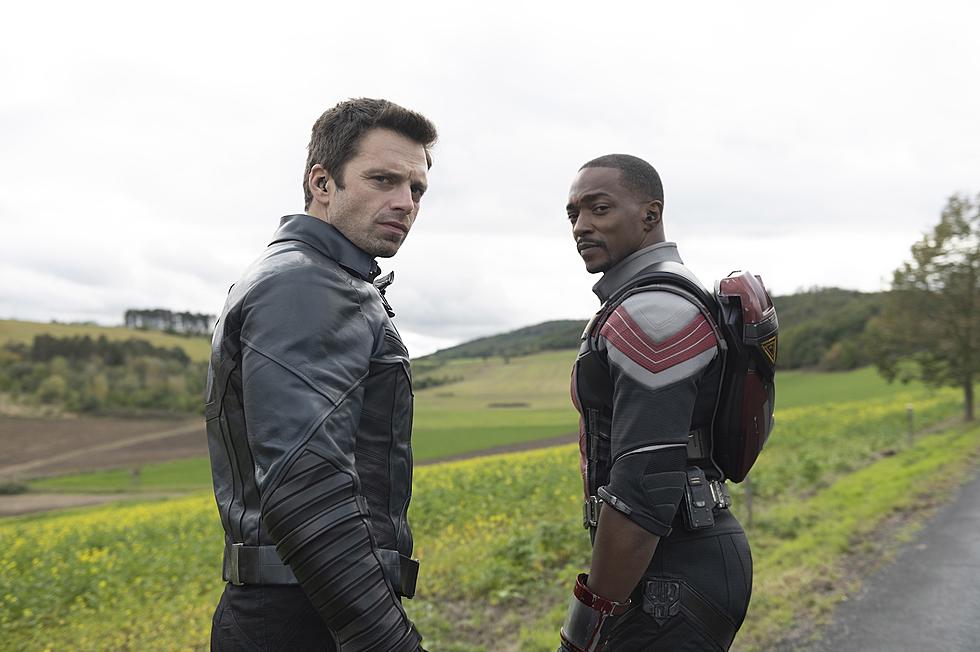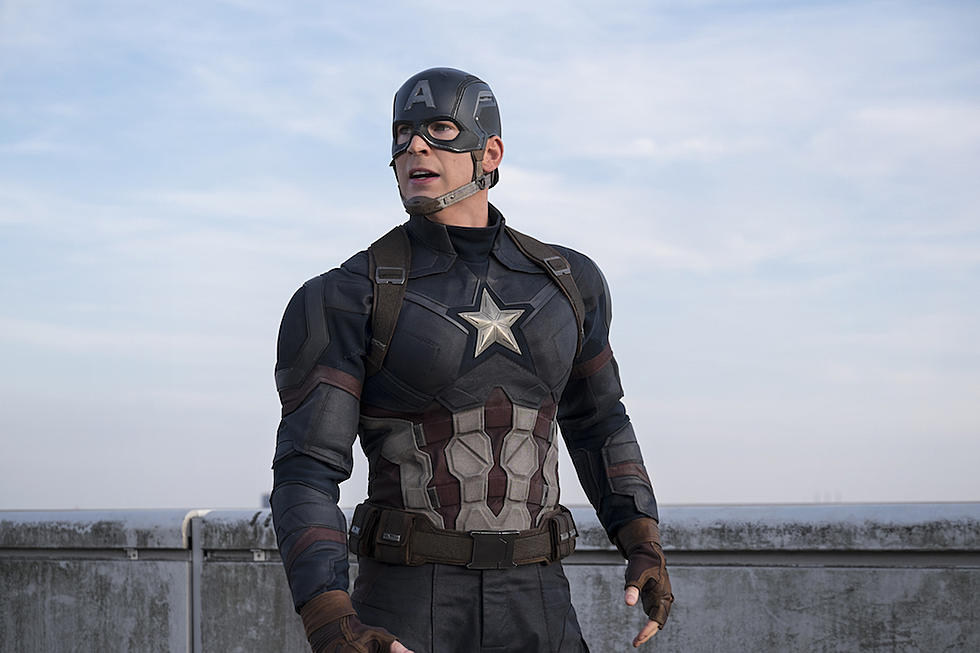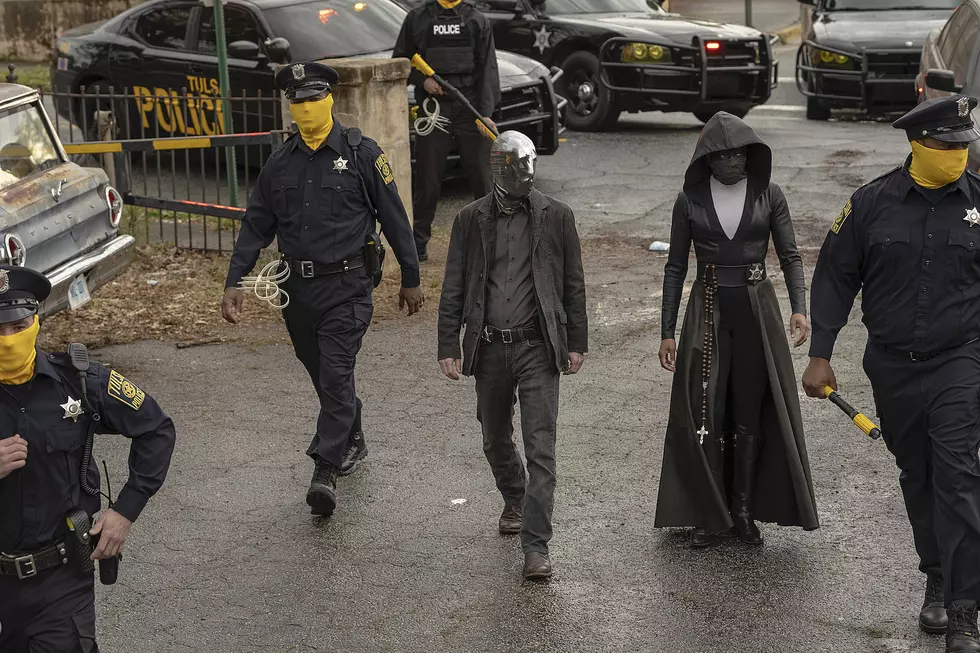
Where Have All The Good Men Gone And Where Are All The Gods? Reflections On The Rifts In Superhero Fandom
Is it Watchmen's fault that Captain America is a Nazi?
That's the strange question I found myself asking after the last month's developments in superhero comics. Thirty years after Alan Moore and Dave Gibbons' Watchmen made its debut, the characters are being integrated into the DC Universe as part of the current DC Rebirth publishing initiative, seemingly as totems of the sort of superhero grimnness that Rebirth hopes to move away from. Meanwhile, at Marvel, the publisher's most principled hero has been retconned as a secret agent of a far-right hate group, at a time when a vocal segment of the audience wants to see a lot more love than hate in the character's life.
Both developments are indicative of a tension at the heart of superhero comics. Thirty years after Watchmen, is it time to stop pointing out that heroes can have flaws, and time instead to acknowledge that heroes can have value?
The superhero is a simple idea that found a home in comic books at a time when there was a need for fictional champions in a world offering few real ones. Most of the fathers of the genre were Jewish writers and artists living in a time of existential fear. While the world at large wasn't aware of Nazi concentration camps until the early 1940s, the first- and second-generation Jewish immigrants that created heroes like Superman were very familiar with the persecution and vilification that led their families to seek new lives in North America.
Superheroes weren't just an escape from the horrors of reality; they were a response to it. In an unjust world the fantasy of justice doesn't fix anything, but it provides a little hope, and perhaps a model for a better way to be. When all else is bleak and terrible, the gift of hope is one of the very real superpowers that storytellers have.
This wasn't naive idealism; this was survival. The superheroes of the Golden Age were meant to inspire. While the Silver and Bronze ages of comics introduced extremes of both absurdist fantasy and social realism, that sense of heroic virtue remained at the core.
That changed in the 1980s, when a new generation of creators popularized a more cynical take on heroism. These writers and artists were operating in a different political context, and faced a different existential threat. Very few of them were Jewish, and very few of them belonged to any other persecuted class. They were not worried about being wiped out because of their identities, and they did not need a champion to stand up for them.
They did face an existential threat, however. This was the era when the possibility of nuclear annihilation was an everyday anxiety, and the ego and aggression of our political leaders was a source of fear. In that context, superheroes as figures of power and authority took on a different tenor, and it made sense to approach them with scepticism. Though directly inspired by Captain Atom, Doctor Manhattan offered a new take on the superman that was emblematic of the horrible indifference of nuclear power.
Watchmen itself is not to blame for what followed, but it is identifiably a foundational text for the paradigm that redefined superheroes for a generation. This era of creators did not believe in noble champions; they wanted characters that reflected a jaded understanding that the world is not good, and no-one is coming to save you. Wolverine, Punisher, Lobo, Spawn; these characters embraced cults of individuality, ideals of vigilante justice, and the necessity of extreme sanctions.
This was an era marked by a conception of "realism" that was no more realistic than the most tiger-headed eccentricities of the Silver Age, but one that lent itself to a hyper-masculine aesthetic of grim self-seriousness. With sales enjoying an enormous upswing in the late '80s and early '90s thanks to the speculator boom, and with books like Watchmen and The Dark Knight Returns proving that even superhero comics could be "literary," everyone with a stake wanted comics to at last be taken seriously. There was no room for the sort of silly joyful optimism of superhero comics' past; there was only room for a barrel of Wolverines, and maybe some boobs.
And this era truly was resolutely masculine, in the most cis-normative, hetero-normative way. Comics sold well to adolescent males (and formerly-adolescent males), and did not need to consider kids, women, or other marginalized groups as part of the possible audience. This was an era in which comics moved from the newsstand to the specialty store; from places where everyone could buy them to places where only self-identified "fans" could do so.
We've been dealing with the ramifications of the "grim 'n gritty" era ever since, both in terms of a business hierarchy that knows what worked when the industry was at its heighest height, and in terms of the current generation of creators being largely brought up on these books. Yet superhero comics' heritage of joyful optimism did not die; in fact, in the 21st century it found new purchase in an unexpected venue: the multiplex.
Sam Raimi's 2002 Spider-Man was not the first of the current era of blockbuster superhero movies, but it was the one that tapped into a renewed public hunger for uncynical champions. Set in New York City, and released less than eight months after the 9/11 terror attacks that hit that city hardest, Raimi's Spider-Man honored the original vision of a character created by two men from immigrant families to illustrate the need to match power with responsibility. Though defined in part by his doubts, Spider-Man is as clear and crisp a symbol of virtue as Golden Age heroes like Captain America and Superman.
Marvel Studios moved into the business of making its own movies in 2004, spurred by the success of Sony's Spider-Man franchise, and chose to emulate that franchise's hopeful and largely unapologetic approach to heroes. Marvel Studios' heroes are flawed, yes --- that is the Marvel hallmark --- but they are decent, principled, and self-sacrificing. They are actually heroic, and not only super. The same trend away from cynicism towards informed idealism manifests on the DC side of the aisle in both animated series and live action TV shows, from Batman: The Brave And The Bold to Supergirl.
And because these movies and shows have significant reach, they've created a new generation of fans who value the embrace of virtue in superhero fiction.
If the traditional comics audience of the last thirty years is very straight, white and male by design, the new audience inevitably skews less male, and presumably less white and less straight. It should be no surprise that groups of people that possess an acute and personal sense of injustice and oppression should be drawn to the fantasy of justice offered by superheroes at their most optimistic. And now that the newsstand is back in digital form, it's easier than ever for these fans to follow their newfound love of superhero fiction into comics. But are there any comics there for them to buy?
Here is the source of the tension in superhero fandom. A new and growing audience wants stories like the ones they've seen on screen; stories that harken back to the ideals of heroism fostered by the likes of Superman creators Joe Shuster and Jerry Siegel. At the same time there is an established audience that find idealism corny; an audience that can comfortably sneer at heroism because it does not need heroes, and can glamorize violence because it does not fear violence.
So while Marvel Studios has been reaching out to new audiences --- at least in the types of stories it tells, if not in the types of characters it centers in those stories --- Marvel Comics has been stuck in a strange rut. Just about all of its major event storylines since the mid-'00s have been about heroes mistrusting and fighting other heroes. That's the basic pitch of House of M, Secret Invasion, Avengers vs X-Men, Original Sin, Axis, Time Runs Out, both Civil Wars, and many more stories besides. There are also Marvel comics that put virtue first, like Ms Marvel, Thor, and Unbeatable Squirrel Girl, but the predominant narrative is that heroes must always fight heroes, and there are no real good guys.
You'll recall, of course, that Civil War provided the inspiration for the third Captain America movie --- but in that comparison the contrast between the comics and the movies is most plainly laid bare. The heroes in the movie are riven with regret, even as they hold to clearly articulated and defensible principles. They are never overcome with hatred, and they seem heroically disinclined to rack up the sort of body count that's such a touchstone of the comics' events that it's become part of the marketing. Whichever side you choose in comics' Civil War, you come away feeling dirty. Whichever side you choose in the movie, you can acknowledge the other side's point of view.
Inevitably I should mention that if you want a hero-vs-hero movie that makes no effort to preserve the idea of heroic virtue, look no further than Batman v Superman: Dawn of Justice, which could not be any more clearly defined by hyper-masculine ideas about violence and cynicism. DC Comics hasn't fared better than Marvel Comics in recent years in this regard, with a Justice League riven with hero-on-hero violence --- even Wonder Woman brandishes a sword --- so it will be interesting to see what lessons are learned as the publisher heads into the Rebirth relaunch.
That the reigning paradigm of Marvel's comics universe is "heroes at war" brings us back at last to the current storyline that perhaps best illustrates the tensions in fandom. The latest comics story to feature Steve Rogers, Captain America, is another fresh twist on heroes mistrusting and fighting other heroes, with Rogers revealed to the reader as a secret Nazi. (If you want to quibble, he's a member of a far-right white supremacist hate group led by a Nazi, and not an official Nazi. But the membership card is not the main thing that people get upset about.)
Captain America as a secret agent of an evil organization is not inherently a bad story to tell, especially the way writer Nick Spencer seems to be telling it. The issue that set up the story, Steve Rogers: Captain America #1, also sets up how it will be undone. There's an all-powerful Cosmic Cube involved; there are hints from Rogers himself that he feels unsettled since he was interfered with by said Cube; there's a character who could well be the Red Skull's daughter Sin dabbling in the past, and "flashback" scenes that probably aren't flashbacks at all, but history being actively rewritten.
The story might be read as an inspired response to the debate about whether a time traveler would be right to kill Hitler as a baby, because it asks instead what the Nazis might do with a time machine. Would they kill their greatest enemy as a boy, or would they turn him? The story is also timely commentary on the spectre of fascism in the West today, where the tendency to fear obvious monsters can blind us to the fact that fascism often arises from familiar, media-friendly faces. There's also rich potential in contrasting the beloved white (but fascist) Cap with the less respected black (and not fascist) new Cap, Sam Wilson. The story offers a rich vein for commentary.
But one can appreciate the intelligence of the story, and even see how it will be undone, and still recognize that it sits right on a tender nerve running through contemporary fandom. If you admit that there is a growing audience coming into comics that wants a version of Steve Rogers closer to the one on the movie screen, this version is not only tone-deaf, but provocatively dismissive. For women, people of color, and LGBTQ people, oppression and violence are often realities of everyday life. A story that says "white men in uniform may not have your best interests at heart" is not a shocking twist; it's a bitterly familiar reality. These fans must feel like they've been invited to the party only to be turned away at the door.
The comic that revealed Steve's new fascist dogma had the bad luck to come out a day or two after the hashtag #GiveCapABoyfriend started trending on Twitter. The hashtag was obviously inspired by the chemistry between on-screen Cap actor Chris Evans and his various male scene partners, including Sebastian Stan as Bucky, Anthony Mackie as Falcon, and Robert Downey Jr. as Iron Man. That the campaign for a gay or bisexual Cap and the establishment of a fascist Cap occurred in the same week is only happenstance, but it drew into sharp relief the chasm that exists between what new fans want and what they can expect.
This current comic book story will pass, and maybe the tarnish of it will fade ---- though there aren't many concepts more likely to permanently stain a character than "Nazi." Yet for some readers, saying "this can be undone" sounds a lot like saying "we can fix the car that ran you down." It suggests Marvel and its defenders haven't noticed where the real harm happened. The most serious damage is not to the character, but to new fans who have been told once again that they're not welcome here.
During last year's Secret Wars event, a miniseries called Planet Hulk by Sam Humphries and Marc Laming seemed to posit an alternative reality where Steve and Bucky might be lovers, but this was never confirmed on the page. Marvel thinks that "Cap is a Nazi" is a story worth telling in its main continuity, but it won't commit to "Steve and Bucky are lovers" even in an alternate gladiatorial world overrun by Hulks. That sends a definite message about what sort of reader Marvel wants; don't expect an official Steve/Bucky coffee shop romance comic any time soon. (If you don't think there would be enough drama in that sort of love story, hoo boy, do I have a whole canon of world literature and theatre to introduce you to. You're in for a treat.)
The new superhero fans want to be included, and there's no reason why they shouldn't be. Yet if fans dare so much as create a hashtag like #GiveCapABoyfriend, they're scoffed at, sneered at, dismissed as "entitled." Creators and editors should welcome these readers, but instead they act like they're under siege. They deride the fans and belittle their concerns; they place their creative integrity in opposition to the possibility that art can respond to culture; and they use the horrible behavior of the worst kinds of fans to dismiss the views of any critics. We should all be united in condemning the use of lies, threats, and harassment to advance an agenda, but that censure should be directed at those responsible if it's going to have weight; it is not meant as a silencing tactic.
Of course, creators and editors may truly feel that they're under siege. That perception is based on a mistaken assumption that the vocal newer fans are invaders, rather than part of an expanding community. The gates are being locked and barricaded against "pretenders," "fake fans" who only came to comics because they saw a movie or a cartoon. But that is not how the superhero comic industry should be. Movies and cartoons are legitimate points of entry; so are fan art, cosplay, and even slash fiction. Some of the oldest fans among us probably saw Spider-Man on a pyjama shirt before we learned to read, so let's not pretend our pedigree is any better. The cultural saturation of superhero characters beyond the comics page is so great today that hardly anyone's first exposure to a superhero is going to be from a comic book. It's no-one's place to check other people's credentials before allowing them to enter fandom or have a voice.
You may recall that I asked at the outset if it was time to stop pointing out that heroes can have flaws. The answer is no; there will always be room for those types of stories, and for the people who want to read them. Marvel's next fractured hero-vs-hero tale will surely sell very well. But there should be room for much more besides. The culture is changing, and people who used to be silent or excluded are not going to stay silent or excluded. This "siege" is just the tearing down of the "No Girls Allowed" sign from the clubhouse wall.
And yes, this is about women first and foremost. The growth and increasing visibility of female fandom is at the heart of this cultural shift --- one that also benefits other marginalized fans by advocating for a more progressive, less masculine climate in superhero fiction.
Here's the emerging truth that everyone in comics needs to get used to: fandom is female now. After thirty years of a very male culture, we're approaching a tipping point where women will outnumber men. Thanks to fan crafts, from cosplay to doujinshi, most of the visible ways that fans engage with and express their fandom are already dominated by women.
Here's the other thing that creators and publishers need to understand; the next generation of creators will come from these areas of fandom. This is where the energy is. This is where the momentum is. You can keep putting up signs that say they're not welcome, but that's not going to stop them. You'd be smarter to let them in and make room. Because if you don't want to give Captain America a boyfriend, you can be damn sure that they will.
Check Out The Best Stucky Fan Art
More From ComicsAlliance









